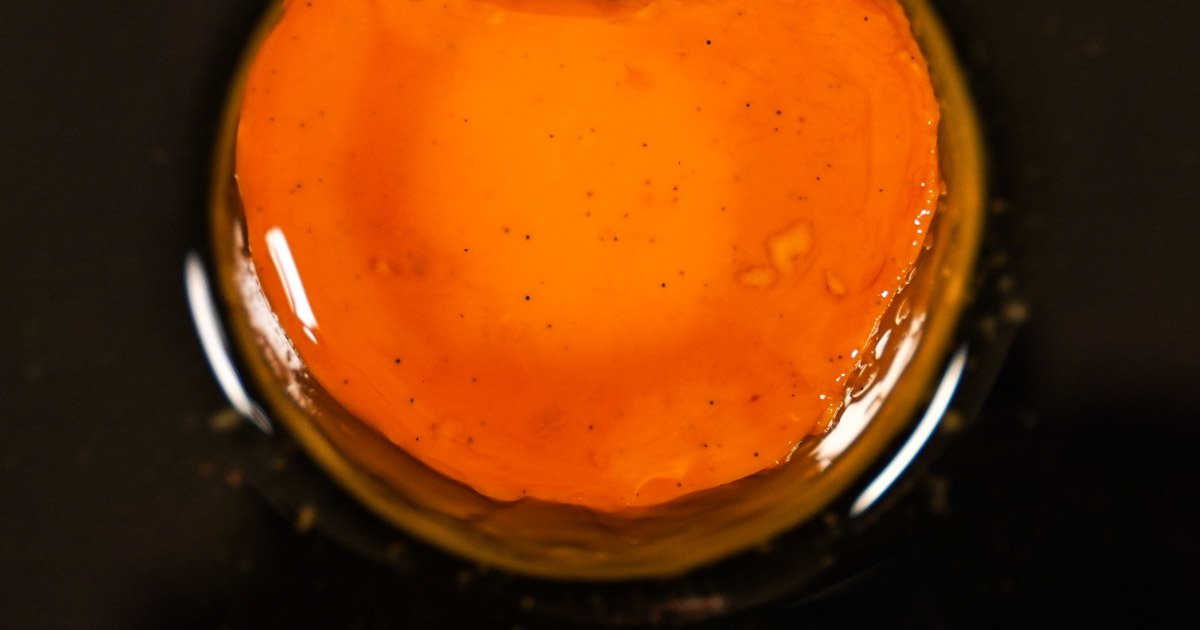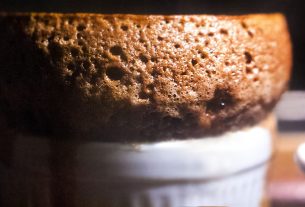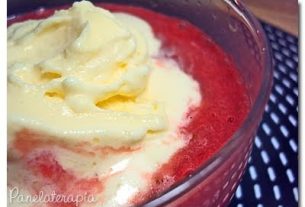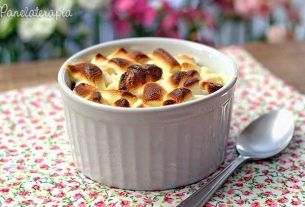When you come across a recipe and you need it, you need to make it. That pudding made with yakult was one of them, the only possible question was: will it be good?
During one of these wanderings on instagram.com/pratofundo (follow us there), the platform suggested a video to me that was exactly the idea behind this dessert. At first I thought it was a classic caramel cream French, but made by an American-Vietnamese creator (@sadguyalexx). Dessert is common in Vietnam, just like our pudding.
The detail to make it Asian is precisely the use of yakult (or fermented milk). When I saw: it can’t be, it can’t be. It will be? I did a search and found other people doing it too, really old videos. In time: yakult is a Japanese product brand and is, of course, very famous in Asia.
I had to do it to find out. And of course, I ended up adapting it: leaving a little more close to our Brazilian pudding. But at the same time with a footprint gourmetized (or technological): I used the thermocirculator.
Thermocirculator to control the texture of the pudding
It’s practically the same recipe as the pudding made in the thermocirculator, the big difference is the exchange of part of the regular milk for Yakult. Some recipes I looked at used 100% Yakult, but the result was a little strange. How is a fermented milk (therefore, it is acidic), similar to the pudding being curdled. Whether it’s because of the condensed milk or the eggs.
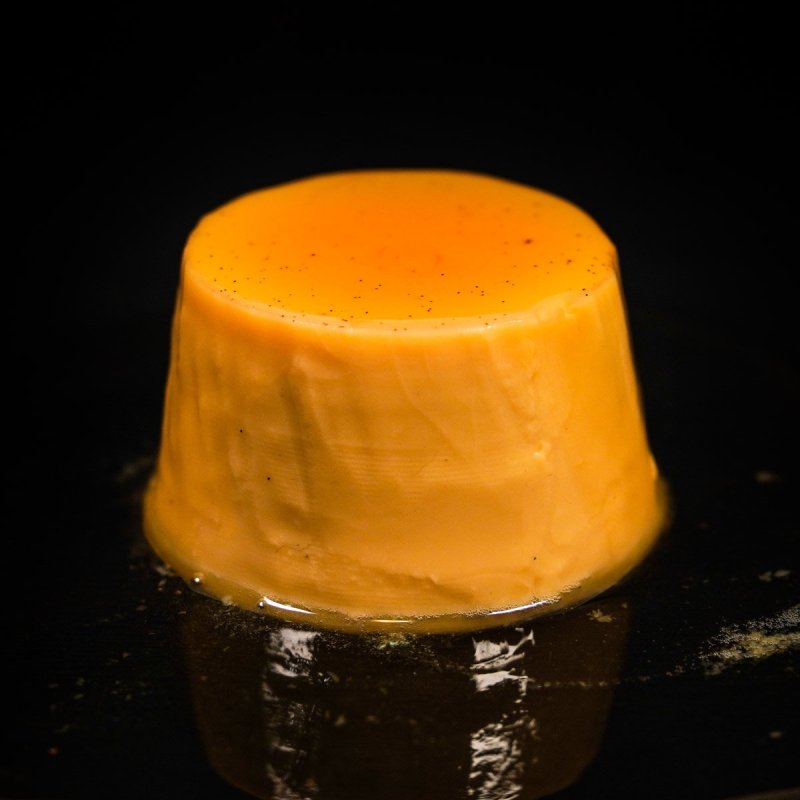

I chose to use the thermocirculator to have greater control and get a lower cooking temperature precisely to compensate for the acidity that already helps to make the preparation more consistent.stori
After all, is Yakult pudding good?
Incredibly (or not so incredibly), yes it’s good. It’s pudding, it has condensed milk, caramel… very difficult to be bad. That said, you can taste the yakult in the pudding. But it was more subtle than I imagined.
Thus, you feel the sour background taste characteristic of fermented milk. At first it causes mental confusion: sour pudding? Oops, is that right? That’s right.
If I did it again, I would change a few things.
- I wouldn’t use lactose-free condensed milk, or I would change brands. The one used was very caramelized and had Maillard reactions, so it had a background flavor already present. Which may have made the pudding milder in relation to the Yakult flavor.
- Be careful with the caramel, in part. With the amount of Yakult used, if the caramel is well caramelized (as it should be) it can also mask its flavor.
- Maybe I would use more Yakult: in my version, I used three 80 mL jars… I would use four and reduce the amount of normal milk.
- And as I mentioned before, it can be acidic, which helps with the texture. Therefore, the cooking time could be shorter: it would leave less time.
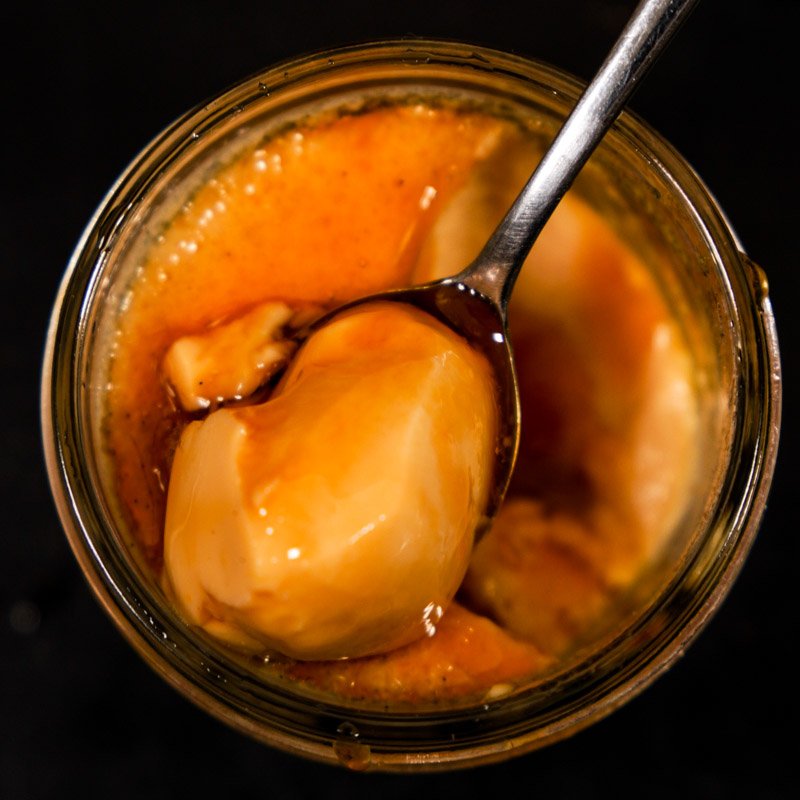

Yakult Pudding (Fermented Milk)
Makes: 9 portions
Condensed milk pudding
- 395 g condensed milk (8% fat; lactose free; 1 can/box)
- 240 mL fermented milk (use yakult)
- 150 g semi-skimmed milk (lactose salad)
- 3 eggs
- 10 mL vanilla extract (or 2-3mL vanilla essence)
Caramel syrup
- 100 g crystal Sugar
- 50 mL water
1 cup: 250mL | 1 tablespoon: 15mL.
Condensed milk pudding
- Heat water with a thermocirculator (sous vide equipment) in a container that holds the pudding containers. I used a 12-liter pan, but a container that retains heat is ideal.
- To speed up the process of heating the water, I heated part of it on the stove until it was lukewarm and then added it to the 12L pan.
- The thermocirculator was set to 80°C to compensate for heat loss when the pudding was added, at which point it was set again to 79.5°C. Reserve.
- Blend condensed milk, eggs, milk, fermented milk and vanilla (if using) in a blender for 2-3 minutes.
- Let sit for 30-45 minutes to remove bubbles.
- To remove any bubbles from the pudding mixture, you can use a blow torch on the surface. Sift the pudding mix
- Distribute around 90-100g of the mixture into each pot. If you use Ball-style jars (Mason Jars) with their normal lids, they should be semi-closed: as if there were a few millimeters left for bubbles to escape.
- I just used the screw ring with a silicone cap, so I could close it.
- Place the glasses in the water bath with the thermocirculator, then remember to adjust the temperature to 79.5°C. Cook for about 40-60 minutes.
- I suggest checking the pudding when it reaches 40 minutes: the pudding should be slightly soft in the center. When you shake the pot, the middle gives a little shake. I left it on for 50 minutes, but I would have taken it off sooner.
- Remove the jars from the water bath and let cool for 1 hour before placing in the refrigerator.
- Let it cool in the fridge for at least 5 hours.
- Serve with the caramel sauce.
Caramel syrup
- Melt sugar in a pan over medium heat, about 5 minutes.
- Stir from time to time to distribute the sugar.
- Add the water carefully (it will bubble) when all the sugar turns to an amber caramel.
- Mix well until all the caramel melts and remove from heat.
- When it cools, it will become thicker. If you want more fluid, add 30-40mL.
- If you want to add the caramel to the pot before the pudding, like a traditional pudding, you can do that too. So, make the caramel beforehand and let it cool a little so as not to have a thermal shock with the glass jars. But it’s still fluid. Just put a layer at the bottom of the pot and let it cool to make it firmer and not mix with the pudding.
- Condensed milk: I used lactose-free Piracanjuba in the test; I recommend using a normal one or another brand. The one used was very dark (which is common and normal), which may have interfered with the final flavor.
- Leite: normal milk can be used, I used lactose-free as I am lactose intolerant.
- glass pot: the pots used in the photos are not sold in Brazil, they are from the American brand Ball. It’s the Regular Mouth model with 4 ounces (about 113mL) and I received it as a gift.
- Alternative glass jar: it is possible to make it in a glass jar suitable for jam/preserve, it cannot be just any jar because of the temperature.
Portion: 100g | Calories: 233kcal (12%) | Carbohydrates: 40g (13%) | Protein: 6g (12%) | Fat: 6g (9%) | Saturated fat: 3g (19%) | Polyunsaturated Fat: 0g | Monosaturated Fat: 2g | Trans fat: 0g | Cholesterol: 71mg (24%) | Sodium: 95mg (4%) | Potassium: 208mg (6%) | Sugar: 36g (40%) | Vitamin A: 213IU (4%) | Vitamin B2: 0mg (18%) | Vitamin C: 1mg (1%) | Calcium: 176mg (18%) | Ferro: 0mg (2%)

Sign up for our newsletter and stay up to date with exclusive news
that can transform your routine!
Warning: Undefined array key "title" in /home/storelat/public_html/wp-content/plugins/link-whisper-premium/templates/frontend/related-posts.php on line 12
Warning: Undefined array key "title_tag" in /home/storelat/public_html/wp-content/plugins/link-whisper-premium/templates/frontend/related-posts.php on line 13

